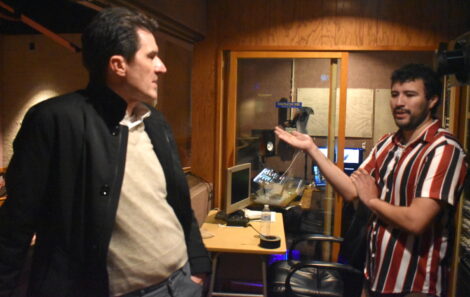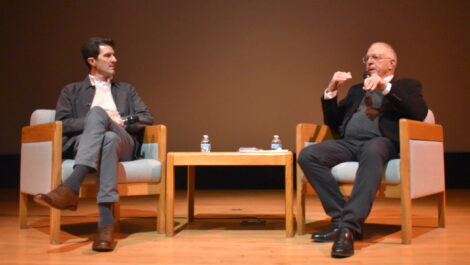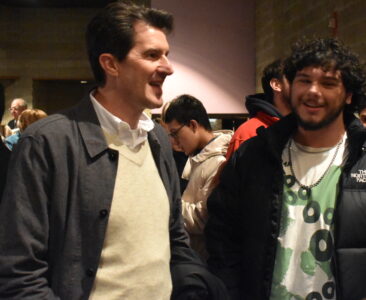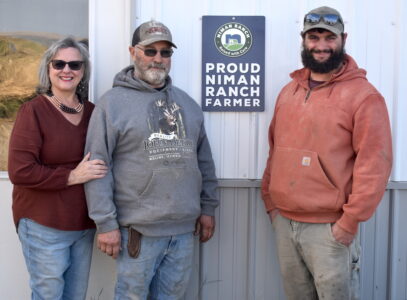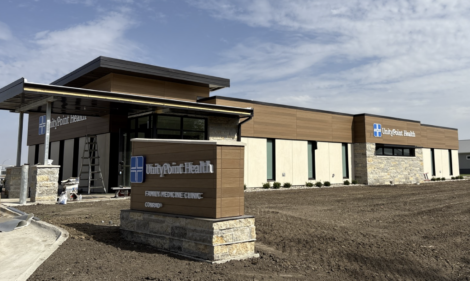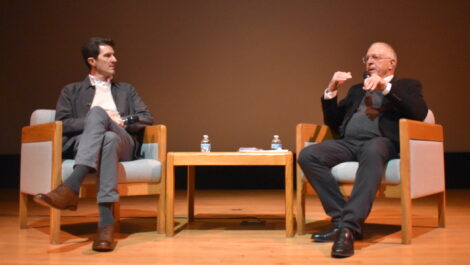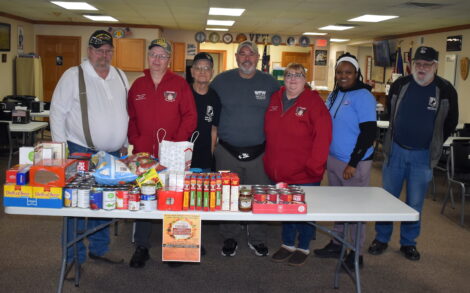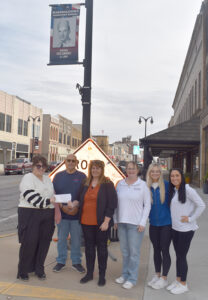Movie magic: Renowned filmmaker Joseph Kosinski returns to Marshalltown to kickstart auditorium fundraiser
- Earlier in the day Saturday, Kosinski toured the Performing Arts Center with a small group that included Auditorium Manager Jose Ramirez, right, to learn more about the facility’s current needs.
- Filmmaker Joseph Kosinski, left, a Class of 1992 Marshalltown High School graduate, converses with moderator David Clark, right, during a question and answer session held at the Marshalltown Performing Arts Center on Saturday night. The event coincided with the 40th anniversary of the auditorium’s construction and a $700,000 fundraising campaign to improve the lighting, sound and shade systems.
- At the conclusion of the discussion with Clark, Kosinski stuck around the lobby of the Performing Arts Center to meet fans, pose for photos and sign autographs.
Sometimes, all it takes is one lucky break.
Marshalltown native Joseph Kosinski may now be known as one of the most successful big-budget directors in Hollywood who has worked with the likes of Tom Cruise, Brad Pitt, Jeff Bridges and Josh Brolin, to name a few, but two decades ago, he was an upstart filmmaker with a background in engineering and architecture battling through rejection and hoping for a chance to prove himself. In an interesting twist considering his hometown’s newly minted status as an eSports hub within the state of Iowa, that chance came in the form of a video game commercial.
Kosinski, 51, a Class of 1992 MHS graduate, told that story and many others during a Q&A event moderated by Dr. David Clark at the Marshalltown Performing Arts Center on Saturday night, which also served to highlight the $700,000 fundraising campaign in conjunction with the 40th anniversary of the auditorium’s opening in 1985.
After brief introductory remarks from Mayor Joel Greer, Auditorium Board Foundation Chairman Gary Schaudt stepped up to the microphone to provide some history of the Performing Arts Center, previously known as the Marshalltown Community Auditorium, share some recent improvements and lay out the future needs that the fundraising campaign seeks to address — specifically, the lighting, shade and sound systems at a total cost of $1.4 million shared with the Marshalltown Community School District (MCSD). Earlier in the day, Kosinski and his parents toured the facility with Auditorium Manager Jose Ramirez along with several other points of interest at MHS, including the band room where Kosinski once excelled on the alto saxophone under the direction of Jerry Ellingson.
A video produced by Ramirez featuring MHS alums like Kosinski, Broadway actor Nicholas Cooper and musicians Amber Duimstra and Nick Lane was then shown to highlight the special place the auditorium holds in their lives as they have pursued creative careers, Finally, Kosinski himself took his seat alongside Clark and spoke for just over an hour, fielding questions from the moderator and others submitted by the hundreds of spectators in attendance.
Once he had shouted out longtime family friend Betsy Mackie for arranging the event, Kosinski recalled the first time he had ever set foot on the auditorium stage back in 1987 as a member of the Miller Middle School jazz band.
“(I was) just amazed at what a beautiful and incredible facility we had in our little town of Marshalltown. It kind of blew my mind at the time. It still blows my mind now walking in 40 years later, but to have such an incredible facility for the arts and to know that this was built for us as students… It was so cutting edge,” he said.
Those foundational memories inspired Kosinski to return and play whatever role he could in catalyzing the fundraising campaign.
“I really believe it kind of still influences the types of things I do every day in my job as a film director,” he said. “Just that support and making me believe that I could do it, a lot of that was formed at a young age in places like this, so I’m really happy to be here and really want all of us to support this place and keep it at the level that it was when it first opened.”
Describing his journey to Hollywood as “a long and winding road,” he grew up not knowing anyone who worked in the film industry but loved going to the Orpheum Theater and seeing movies like “Top Gun” — Kosinski, of course, would famously direct its smash hit sequel over three decades later. After excelling in music and academics as a high schooler, he went off to Stanford University to study mechanical engineering, and during his senior year in college, a professor told him he had “a great eye” when commenting on speaker stands he had built for a project.
The instructor recommended pursuing architecture or design, and Kosinski subsequently applied to several architecture schools and got accepted by Columbia University in New York City at a time when digital tools and 3-D animation software were rising to prominence. He began creating short films as part of assignments and enjoyed them, and “Desert House,” which he made during his third year, was accepted into a digital film festival.
A representative for an advertising firm that worked with Nike happened to attend one of the screenings and offered him $10,000 to make a short commercial. Over six months, Kosinski and some friends produced “Les Jumelles,” and that led to two more commercials for Nike.
From there, Kosinski sent his work to renowned music video director Mark Romanek, who told him it was “great,” and Romanek subsequently passed it on to David Fincher, the heavyweight Hollywood filmmaker behind “Se7en” and “Fight Club,” among others.
Kosinski got signed by a commercial production company and moved to Los Angeles. At the time, he felt that his career was taking off, but he quickly encountered the harsh reality of no work for a year and a half after 26 unsuccessful pitches.
“It was a hard dose of reality, but it was also a really important time when you learned a process of trying and failing over and over, how to pitch your ideas and how to communicate, how to sell yourself, how to sell your idea. That’s such an important part of the job that I didn’t know,” he said.
His break finally came through the aforementioned connection to Fincher, whose feature film “Zodiac” based on the real-life San Francisco serial killer had been greenlit and forced him to pull out of an obligation to direct a commercial for the new video game “Gears of War.” He recommended Kosinski for the job, and the resulting trailer — known as “Mad World” because of the song that played during it — is still seen as iconic among gamers almost 20 years later.
From there, he was hired to direct an ad for “Halo,” and before long, he had a meeting with Disney about a proposed sequel to “Tron,” a cult classic from 1982 that was the first movie ever to utilize Computer Generated Imagery (CGI).
He convinced Disney to give him $1 million to create a concept trailer for a film that didn’t exist yet, and Kosinski spent about six months making it. Jeff Bridges had starred in the original “Tron,” so the director approached him and asked him to appear in the trailer. He said yes, and the finished product went over so well — going viral after being shown at Comic-Con — that Disney greenlit a feature length film. Nine months later, he was on set shooting his debut, and Kosinski now has six movies to his credit as a director, including “Top Gun: Maverick,” which grossed nearly $1.5 billion, and 2025’s “F1” starring Brad Pitt.
Clark joked that Kosinski was especially enthusiastic while touring the new MHS eSports room earlier in the day before diving more in-depth to the films he has made since “Tron: Legacy.”
Despite the prevalence of CGI and digital effects in modern filmmaking, Kosinski said he prefers to shoot as practically as possible and worked with Sony to build minute IMAX quality cameras that could capture the hyper-realistic, high speed racing action in “F1.” Seven-time F1 champion Lewis Hamilton, who served as a producer on the film, challenged Kosinski to capture that authenticity in his movie, which he felt hadn’t been achieved in past Hollywood productions about Formula 1.
Despite warnings that racing movies didn’t work and weren’t moneymakers for studios, “F1,” which was released in June, has grossed over $630 million worldwide, becoming the highest-grossing sports film ever. Kosinski found his inspiration through the Netflix documentary series “Drive to Survive” and its focus on the teams that were at the back of the pack as opposed to the winners.
Hamilton, a friend of Tom Cruise, had wanted to play a pilot in “Top Gun: Maverick,” and Kosinski reconnected with him when he was developing “F1.” Legendary Producer Jerry Bruckheimer jumped onboard, and after a meeting with Brad Pitt, the star quickly committed to the project. With the director, producers, star and screenwriter set, they pitched the film to nine different studios and received nine offers — ultimately, they chose Apple after receiving a theatrical release commitment and a promise of creative freedom.
Because the finale was shot during a real race in Abu Dhabi, Kosinski told the audience he basically had a short timeframe and two or three takes to get it right, which he managed to pull off and compared to “a cinematic pitstop.” As the conversation shifted to “Top Gun: Maverick,” the first item of discussion for the Marshalltown crowd was the brief inclusion of Cecil’s Cafe, the iconic and now-defunct roadside diner along Highway 30 on the south edge of town.
“I heard that was popular here,” he said to a raucous round of applause.
One of Kosinski’s early ideas for the film was Maverick (Cruise), testing a top secret fighter jet, having an “incident” and wandering into a roadside diner to figure out where he was. When it came time to name it, he went back to his roots, and Kosinski sent the producers a picture of an old sign as a Marshalltown “Easter egg.” It became something of a phenomenon locally with t-shirts created, and he joked that his next task is to work Zeno’s into a future film.
Kosinski weighed in on the role of Artificial Intelligence (AI) in filmmaking, describing the technology as an enormously powerful tool and recalling that CGI went from being a new, largely unknown tool to nearly ubiquitous. He felt AI would help reduce costs and make shooting faster, but he still believes that human beings ultimately have the best ideas.
He also spoke to the audience about the process of audience testing a film before its release and noted that “Only the Brave,” which featured a star-studded cast and chronicled the real-life story of the Granite Mountain Hotshots firefighters, failed to find box-office success despite strong audience testing because of a real-life wildfire in Northern California the same weekend the movie was released.
“You never know if a movie’s gonna work, but what you do know is how an audience is gonna respond to it. And it’s up to your decision as a director to respond to it and try to make your movie better and stick to your guns and feel like you’re on the right path,” he said. “It’s a really fascinating, interesting process, but you never know what’s gonna happen until opening weekend.”
One of the fascinating developments from the success of “F1,” he added, is that its third biggest market was South Korea, and there is now significant interest in hosting a race there. When Clark noted that Kosinski had returned to Marshalltown for a screening of “Only the Brave,” he mentioned the idea of screening a future film at the Performing Arts Center once the desired improvements are completed.
Although one of his recent films, “Spiderhead” was distributed by Netflix, Kosinski remains a strong proponent of the theatrical experience as he discussed the delayed release of “Top Gun: Maverick” and also recommended seeing his films in IMAX theaters. The director’s next major project is a feature adaptation of the popular 1980s television series “Miami Vice,” with Austin Butler and Michael B. Jordan currently in talks to play the leads. Michael Mann previously adapted the source material into a 2006 film starring Colin Farrell and Jamie Foxx.
“Miami Vice,” set in the 1980s, will be Kosinski’s first period piece and a throwback to his own adolescence. For the last 15 minutes or so, Clark asked questions the audience had submitted, which covered how Kosinski’s engineering background benefited him as a filmmaker, how he handles creative differences with actors, the process of turning a script into a finished movie, what a typical day on set looks like (12 hours plus a one hour lunch break), shooting scenes out of sequence, the role of music in his movies and the all-important topic of his experiences working with Cruise and Pitt, two of the biggest stars in Hollywood.
Cruise, Kosinski said, has been a huge supporter and proponent of his work dating back to when he starred in the 2013 film “Oblivion,” Kosinski’s second directorial effort. He recalled their initial meeting at the Burbank Airport at Cruise’s request, when the actor pulled into a hangar in a motorcycle, pulled up next to him in a hangar, removed his helmet and said “Hi, I’m Tom.”
“He loves movies more than any other person I’ve ever met. He lives and breathes movies. It’s what he thinks from the moment he wakes up until before he goes to sleep. He is all in and so committed and so dedicated and such a cheerleader for everyone who makes films,” Kosinski said. “He’s incredible to work with, and I’m very lucky to work with him.”
Pitt, on the other hand, is a “slightly more reluctant” movie star with an introverted personality, but Kosinski said he was born to play Sonny Hayes in “F1.”
“They’re both great, that’s the answer,” he said.
After the formal discussion with Clark concluded, Kosinski made one last push for the auditorium fundraiser and expressed his gratitude for the opportunity he had been provided.
“I’m so proud to have grown up in this town, and it’s so nice to come back and see everyone. Let’s get this auditorium back to the shape it should be in, and then next time, I’ll bring a movie, we’ll watch it together and we can talk about it,” he said.
He stuck around in the lobby afterwards to sign autographs, pose for photos with fans and even take time to partake in a brief interview with the T-R. Kosinski reflected on his excitement about seeing so many people who remain passionate about the movies amidst widespread concern about the future of theatrical releases due to the seeming ubiquity of streaming services.
“When I meet people who love the movies, especially younger people who grew up in the world of streaming and having everything on their phone, to hear them say they went to theaters and saw something four times, that’s why I do it. That’s the experience I’m trying to create, which is the same one I had when I was a kid,” he said.
Reflecting on the box office success of 2025 releases like “F1,” “Sinners” and “Weapons,” which features fellow Marshalltown native Toby Huss in a supporting role, Kosinski added that he felt the onus is on filmmakers to tell great stories and come up with original ideas that draw audiences to theaters. As a director who has made both original films and sequels based on established intellectual property (IP), he said he approaches every project the same way regardless of the source material.
“Even when working on a piece of IP, never take it for granted. Never think that people are gonna show up just because of the title. It has to be a great story,” he said. “It has to have great characters. You have to show the audience something they haven’t seen before. Every single one is a challenge, and I make every movie like it’s my last, like you’ll never get another shot at it. That’s the attitude you have to have.”
While his current focus is on the “Miami Vice” adaptation, Kosinski is also developing an “All the President’s Men” style conspiracy thriller about the two whistleblowers who testified before Congress on Unidentified Flying Objects (UFOs) for Apple, an unnamed historical epic and sequels to both “Top Gun: Maverick” and “F1.”
“It’s fun. It’s what I was born to do. It just took me a while to figure it out,” he said.
——
Contact Robert Maharry at 641-753-6611 ext. 255 or rmaharry@timesrepublican.com.

